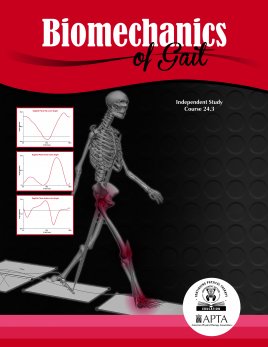
Biomechanics of Gait
Contact Hours: 0
| Online Only | |
|---|---|
| APTA Orthopedics Member | $35 |
| Non-APTA Orthopedics Member | $50 |
Note: CEUs are not offered for this course.
Course Description
This 3-monograph series is designed to provide the reader with an understanding the lower extremity biomechanics during gait. Clinical applications are highlighted and research findings are applied to enable effective decision-making for evaluation and treatment of select gait deviations. Cases studies are provided for each monograph.
Course Overview
Course Format: Online
Course Objectives
- Understand the normal spatiotemporal characteristics of the hip, knee, and ankle-foot complex during gait.
- Understand the kinetics and kinematics of the joints of the lower extremity during the gait cycle.
- Identify similarities and differences between walking and running for the lower extremity.
- Discuss the manner in which joint coupling transfers torque throughout the kinetic chain.
- Describe the sequential concentric and eccentric muscle actions that occur during the stance phase of locomotion.
- Discuss the stresses imposed by common foot strike running patterns.
- Characterize the gait deviations commonly observed after specific orthopaedic injuries of the lower extremity.
- Describe the evidence for interventions suggested to improve aberrant gait deviations in the lower extremity.
- Understand the clinical implications of persistent aberrant gait patterns.
- Describe therapeutic strategies to manage mechanobiologic processes that can ultimately lead to tendon and articular cartilage degeneration in the foot and ankle.
- Discuss the limitations of the current evidence-based practice to address aberrant gait patterns after orthopaedic injury of the hip, knee, and ankle-foot complex.
- Identify potential future directions for research on treatment of gait deviations that occur following orthopaedic injury.
Topics and Authors
- The Hip
Abagale Reddy, PT, DPT; Julie Bage, PT, DPT, OCS; David Levine, PT, PhD, DPT, OCS, CCRP, CertDN - The Knee
Stephanie L. Di Stasi, PT, PhD, OCS; Erin H. Hartigan, PT, DPT, PhD, ATC, OCS; James Selfe, PhD, MA, GD Phys, FCSP; Jim Richards, BEng, MSc, PhD; David Levine, PT, PhD, DPT OCS, CCRP, CertDN - The Foot and Ankle
Gary B. Wilkerson, EdD, ATC, FNATA; Barry Dale, PT, PhD, DPT, ATC, SCS, OCS, CSCS; Richard G. Alvarez, MD
Add To Cart
Which version of the course would you like to purchase?
Members Only
You need to be a member to buy this course.
Join today to enjoy exclusive deals and prices on all courses.
Join Now